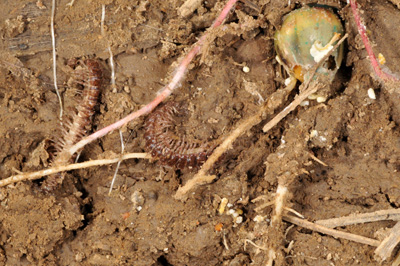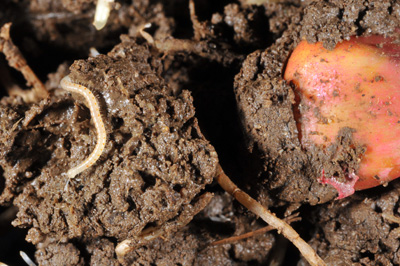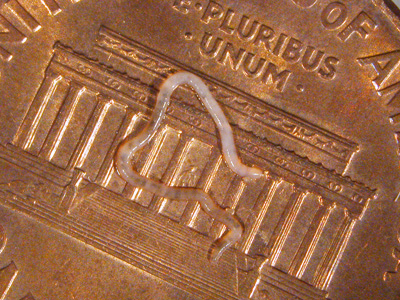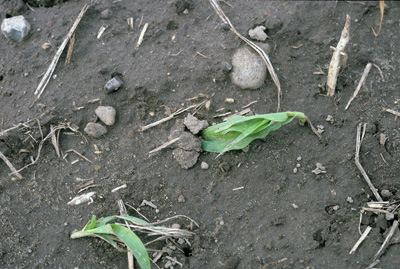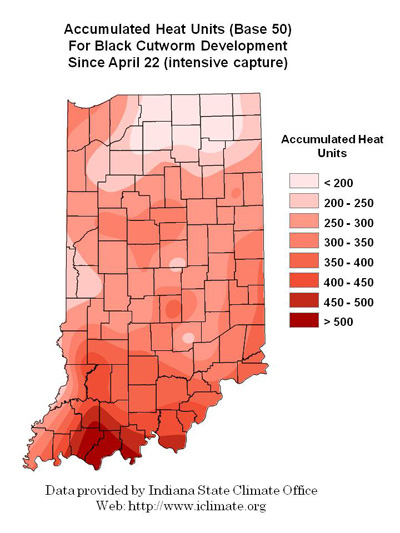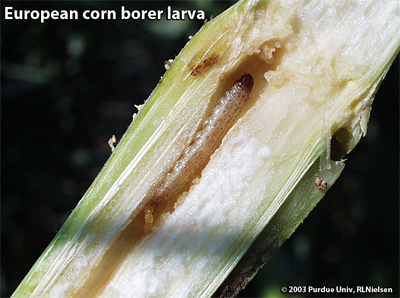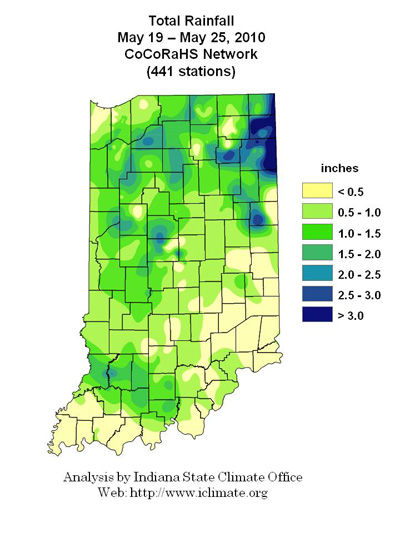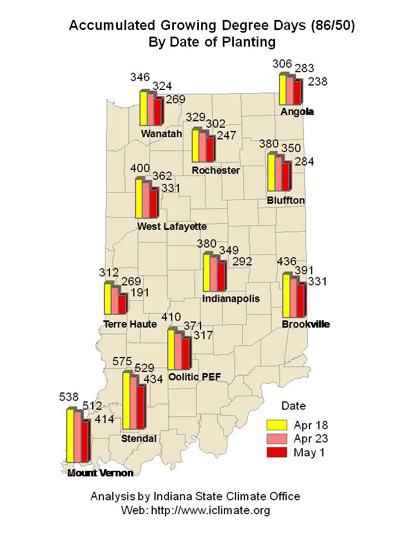Pest & Crop Newsletter, Entomology Extension, Purdue University
- Western Bean Cutworm Season Begins With a Flurry
- Western Corn Rootworm Beetles Emerging
- Black Light Trap Catch Report
- Notched Leaf Edges in Corn
- Soil Sampling for Assessing Plant Available N Following Excessive Rain or Flooding
|
||||||||
Dead/Dying Seedlings, Critters Aplenty – (Christian Krupke and John Obermeyer)
Finally the sun is out, fields are drying, and temperatures have surged. As pest managers inspect crops that have been subjected to an extended period of poor growing conditions, a multitude of critters are being found in the soil. Some are known pests and several are being falsely accused of causing stand reductions. Here are a few of the more common inhabitants of moist fields. Millipedes are wireworm-like arthropods (like insects, they belong to the Phylum Arthropoda-means “jointed foot”), having two pairs of legs per body segment. They have become more prevalent as no-till production becomes more widespread. They are often found in large numbers, but are rarely a pest. This is because they typically feed as scavengers, feeding on dead or decaying materials often associated with seedling blights. Several pest managers have reported numerous millipedes in and around corn kernels/sprouts that have been in the ground for two or more weeks. These kernels were probably the victims of pathogens of some kind (bacteria/fungi) and opportunistic millipedes were merely acting as the “clean-up crew” and hollowing out kernels that were in early stages of decay. Millipedes among a rotting seedling Immature millipedes are smaller and lighter in color. Juvenile (“baby”) earthworms and potworms are closely related and common animals found in soils. They are small, generally colorless, and often less than 1/4 inch long. These worms feed on damaged and decaying plant remains, not live tissue. Therefore they are closely associated with the decaying plant parts and surrounding soil and sometimes wrongly accused of damaging seedlings – in fact, they usually arrive after the seed is dead. In fact, their mouthparts are incapable of causing damage to live tissue – they don’t have “teeth” and instead are specialized to suck up partially-liquefied material. The point of all this is to reiterate that pest managers should keep an open mind when diagnosing field problems. As one submitter confessed, he was so convinced that it was an insect problem and therefore looked for anything moving when he couldn’t find grubs or wireworms.
Many other critters, e.g., mites, symphylans, and springtails, have been observed on or around rotting seeds/seedlings. They are small, some fast moving, and certainly unfamiliar to most. They are not causing the poor emergence/growth, but taking advantage of weak and dying plants (including dead weeds and crop debris from previous years) in various stages of decay, as well as the hospitable environment supplied by atypically wet soils. Potworm on a penny Millipedes damaged this seedling growing in an open seed slot...planted too wet It’s not a nematode: Juvenile (“baby”) earthworms and potworms are closely related and common animals found in soils. They are small, colorless, and often less than 1/4 inch long. As you would expect, these worms feed on damaged and decaying plant remains, not live tissue. Therefore they are closely associated with the decaying plant parts and surrounding soil and often wrongly accused of damaging seedlings – in fact, they usually arrive after the seed is dead and are incapable of causing damage to live tissue. Pest managers should keep an open mind when diagnosing field problems. As one submitter confessed, he was so convinced that it was an insect problem and therefore looked for anything moving when he couldn’t find grubs or wireworms. Night crawlers will occasionally pull the live corn leaves down into their holes Many other critters, e.g., mites, symphylans, and springtails, have been observed on or around rotting seeds/seedlings. They are small, some fast moving, and certainly unfamiliar to most. They are not causing the poor emergence/growth, but taking advantage of weak and dying plants in various stages of decay.
In this video, Christian Krupke shows slugs and their damage, describes scouting and why they aren't easiy controlled. Especially pertinent is the impace of warm and sunny days on future slug feedings
Bug Scout says, "Seedling corn should be scouted for black cutworm leaf feeding and cutting!"
Click here to view the Black Light Trap Catch Report
A Compendium of Biotech Corn Traits – (Bob Nielsen) Corn hybrids containing transgenic traits (aka GMO, biotech) were once a novelty, but now occupy the overwhelming majority of the acres of commercial dent corn grown in the U.S. In 2009, the United States Dept. of Agriculture estimated that approximately 85% of the U.S. corn acres were planted to biotech hybrids (USDA-NASS, 2009). Percent of US corn acres planted to biotech corn hybrids since 2000 The two broad categories of transgenic traits available to U.S. corn growers today include resistance to certain insect pests and tolerance to certain herbicides. No more. No less. Sounds simple, doesn’t it? Well, it is a little more complex than that. There are two general categories of transgenic insect resistance available in corn. Both are governed by genes obtained from soil bacteria known as Bacillus thuringiensis and are referred to as “Bt” genes. The first category of Bt genes confer resistance to rootworm species (Coleoptera, Diabrotica sp.). The other category of Bt genes confer resistance to “moth” type insects such as European corn borer, Southwestern corn borer, western bean cutworm, fall armyworm, corn earworm, and black cutworm. Within each category of insect resistance, plant breeders have available two or more “flavors” of the Bt gene that they can work with. There are also two broad categories of herbicide tolerance biotech traits in corn. One confers tolerance to glyphosate (Roundup® and assorted generics) and the other offers tolerance to glufosinate (the so-called “Liberty Link” trait). To complicate things further, biotech traits are not defined simply by the particular “flavor” of the responsible transgene. The chromosomal location of the transgene also defines the genetic event. Two different genetic events may contain the same “flavor” of a transgene, but are marketed under different trade names because the transgenes occupy different positions within the chromosomal makeup of the hybrid. One example is Syngenta’s Agrisure® CB/LL trait and Monsanto’s YieldGard® Corn Borer trait. Both traits contain the same Bt transgene (Cry1Ab), but because the transgenes occupy different chromosomal locations they are named as different genetic events (Bt11 vs. Mon810) and marketed under different trade names. European corn borer larva Additionally, this Syngenta event also contains the “pat” transgene that confers tolerance to the herbicide glufosinate. The “pat” transgene was included in the event as a selectable marker that enabled the researchers to more easily identify “successful” genetic transformations during the development of the Bt event. This dual-purpose use of the “pat” transgene for glufosinate tolerance is also evident in the TC 1507 and DAS-59122-7 Bt events from Dow Agrosciences / Pioneer Hi-Bred, but not in the Monsanto Bt events. Finally, so-called “stacked” hybrids contain two or more biotech traits packaged together in a single hybrid. For example, Monsanto’s YieldGard® Plus contains two Bt transgene events; one for the control of rootworms and one for control of several of the corn borer species. So, even though there are only two broad categories of biotech traits available in corn today, there are many different “flavors” to choose from, packaged in many different combinations and it is easy for growers and consultants alike to become confused. The following table lists and describes the biotech traits available in 2010 for U.S. corn growers according to the trade name of the transgene event. The information was copied directly from a database maintained and published by the National Corn Growers Association (NCGA). The information is based on annual surveys of the seed industry by the NCGA and, consequently, the accuracy the information is dependent on the accuracy of the completed surveys. For the latest up-to-date listing of biotech traits, visit the NCGA database online at <http://www.ncga.com/know-you-grow>. That Web site offers the additional advantage in that you can click on each event name to view a list of commercial hybrid names and brands that contain each specific event. A complementary source of background information on transgenic crops of all sorts is the GM Crop Database maintained by the Center for Environmental Risk Assessment. This resource offers more technical information about the myriad of transgenic events that exist today. Click here to download a PDF Table. Related References Acreage. 30 June 2009. USDA Nat’l Ag. Statistics Service. [online] <http://usda.mannlib.cornell.edu/usda/nass/Acre//2000s/2009/Acre-06-30-2009.pdf> [URL accessed May 2010]. CERA. (2010). GM Crop Database. Center for Environmental Risk Assessment (CERA), ILSI Research Foundation, Washington D.C. [online] <http://cera-gmc.org/index.php?action=gm_crop_database> [URL accessed May 2010]. Know Before You Grow. 2010. National Corn Growers Association. [online] <http://www.ncga.com/know-you-grow> [URL accessed May 2010]. |
||||||||
|
||||||||
Total Rainfall May 19-May 25 Accumulated Growing Degree Days
| ||||||||
|
||||||||

